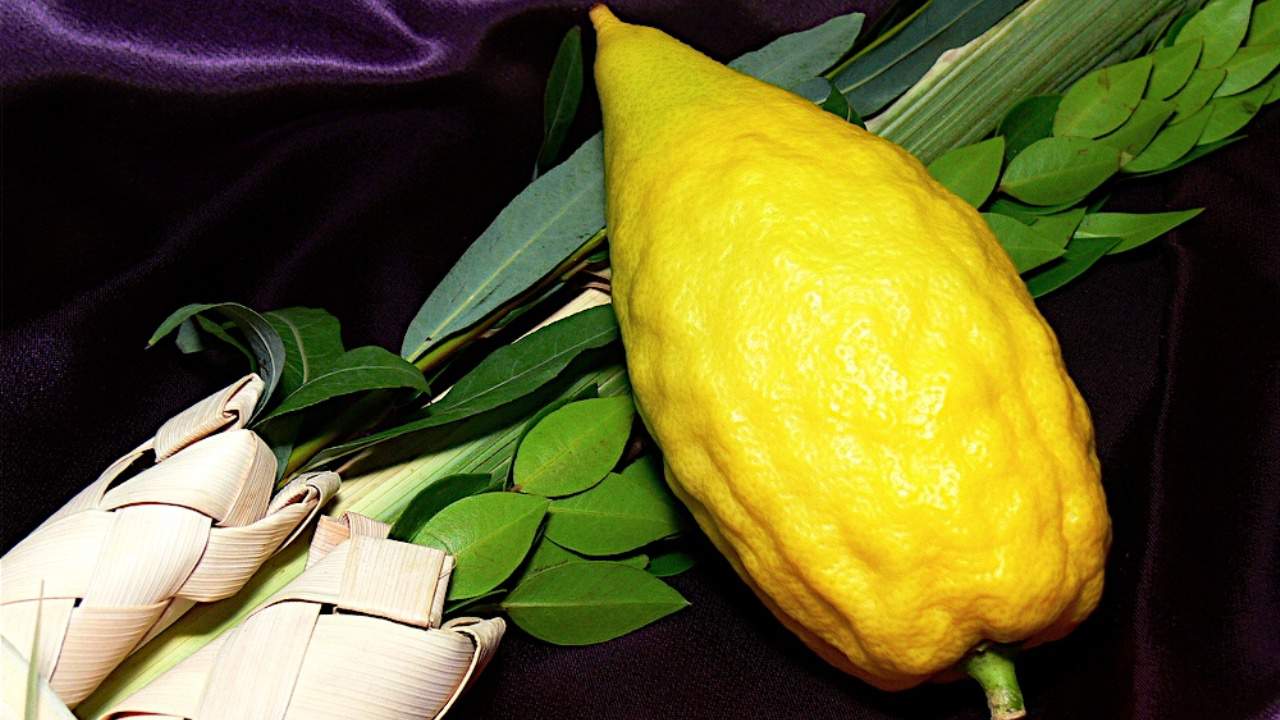Rabbi Mordechai Becher’s BLog – The Four Species – Sukkot 5776
Origin of the Species
Sukkot features one of the most unusual and picturesque mitzvot, known as the arba minim, the four species. The Torah tells us:
You shall take for yourselves on the first day, the fruit of a beautiful tree, the branches of date palms, branches of the thick tree, and brook willows; and you shall rejoice before God, your God, for a seven-day period…
During the morning service the synagogue is awash in shades of green and yellow as everyone stands with their lulav and etrog. A blessing is recited and the four species are gently shaken or pointed in all directions.
Maimonides, based on the Talmud’s oral tradition explains which species the verses refer to:
“Date palms” that are mentioned in the Torah are the branches of the palm tree that grow before the leaves separate to either side, it has the appearance of a staff, and is called a lulav.
The “fruit of the beautiful tree” mentioned in the Torah is the etrog (citron).
The “branches of the thick tree” that are mentioned in the Torah are the haddas, the myrtle, whose leaves cover its branches.
“Willows of the brook” that are mentioned in the Torah are not any plant that grows by the brook; rather they are specific type of willow that is called “willows of the brook.”
Before Sukkot, the most beautiful specimens of a palm branch, three myrtle branches, two branches of willow and a citron, etrog are obtained. Local synagogues and Judaica stores usually sell these items, which are often imported from Israel. The branches are then tied together with palm leaves awaiting there use in the morning service on Sukkot. Immediately after the silent prayer, a blessing is recited, the etrog is taken in the left hand, the other three species, often referred to as the lulav, are held in the right hand. Together, they are gently shaken in six directions, east, south, west, north, up and down. The lulav is also held and shaken at specific points in the Hallel prayer. (Hallel, “Praise,” consists of selections from Psalms that are recited and sung on festivals and joyous occasions.) Afterwards, a Torah scroll is taken out of the Ark and held by someone at the Bimah, in the center of the synagogue. The congregation then walks around the Bimah, holding their lulavim (pl.) and reciting prayers known as Hoshanot.
What the Species Say
In addition to fulfilling a commandment of the Torah with the four species, the action, drama and pageantry of the mitzvah also convey important messages. Maimonides understands the four species as an expression of our gratitude to God for the Land of Israel. He writes:
The species represent the bounty of the Land of Israel; with them we express our gratitude to God for taking us from Egypt and blessing us with the beautiful and rich Land of Israel.
Others understand the four species in a broader sense. Rabbi Hirsch suggests that they represent four different ways that we benefit from the natural world. He begins with an observation made by the Sages of the Midrash that the etrog, can be eaten and has a pleasant smell. The lulav, from a date-palm, has no aroma but does provide food. The myrtle has a pleasant aroma but cannot be eaten. The willow offers neither food nor aroma — it is just wood. Rabbi Hirsch explains that these are parallel to different elements found in nature. Some things are of benefit to us without requiring any human touch, such as air, light, beauty and pleasant aromas. Other things, such as most foods, are inherently beneficial to humanity but need some human involvement for the benefit to be extracted. Sometimes, it is entirely dependent on human effort to process and extract from the raw materials (e.g. wood) a valuable product, such as dwelling, clothing and utensils. In Rabbi Hirsch’s words,
Take these four [species] as standing for all that God offers you as gifts of nature; take them as your very own before the Lord, your God; acknowledge and acclaim that it is God Who gives to you all that is good in life. Cling to them only as the means of living in the presence of God according to His will; rejoice in them before your God as the means of fulfilling your duties.
Another beautiful explanation is found in a source dating back to the times of the Mishnah (170 – 200 C.E.). According to this explanation taste symbolizes actions and scent symbolizes learning. Thus, the etrog which has taste and scent symbolizes a Jew with both the merit of actively performing mitzvot as well as studying Torah. The lulav represents a Jew who fulfills mitzvot but does not study; the myrtle, one who studies but does not fulfill, and the willow, one who does neither. The four types of Jews are bound and held together, an action which expresses the inherent unity of the Jewish people, and the importance of every individual. Every single Jew contributes towards the achievement of the nations goals, even if he or she appears to have no merit at all.
Shake it Up Zaide!
What is the significance of shaking (or pointing) the lulav in six directions? If we understand the mitzvah as an expression of gratitude, the six directions indicate that God’s benevolence and power is found wherever we turn, whether it be the four points of the compass, the heavens or the earth. In addition, pointing the lulav in all directions demonstrates our belief that God’s presence is everywhere and that He is in control of all of existence. It is interesting to note, that the lulav is held still when we recite God’s name and is only moved when reciting the other words of the prayer. Perhaps this is meant to remind us that God should be at the center of everything we do and everywhere we turn.
Another understanding of the shaking is based on a verse in Chronicles;
The heavens will be glad and the earth will rejoice; let them declare among the peoples, “God reigns!” The sea and its fullness will roar; the field and everything in it will exult: Then all the trees of the forest will sing with joy – before God, for He will have come to judge the earth.
The verse states that the “trees of the forest… sing with joy” in the presence of God. Nature is a servant of God, and through its functioning, it is in a sense, part of a beautiful symphony of praise to its Creator. When we shake the lulav during Hallel, we are imitating the shaking of branches and the rustling of leaves in the forest, which is also a song to God.

